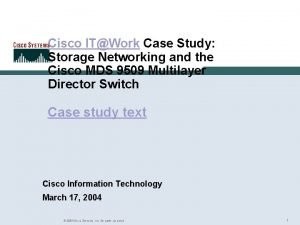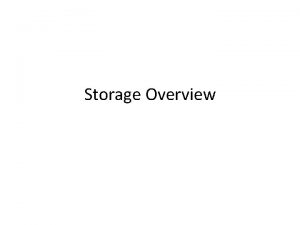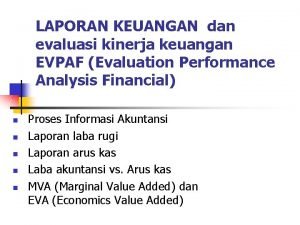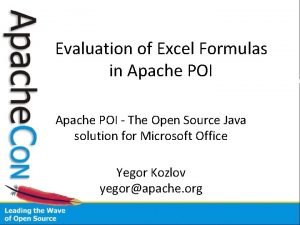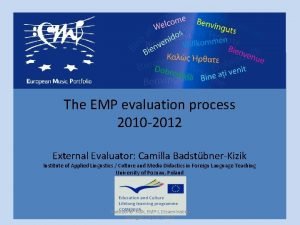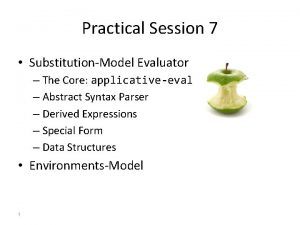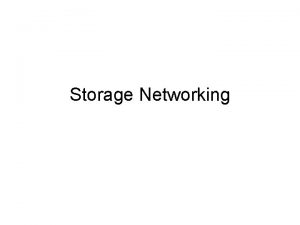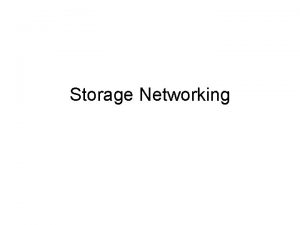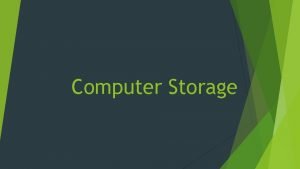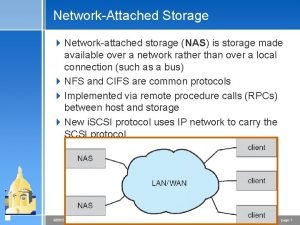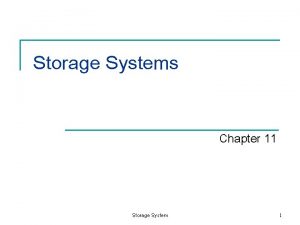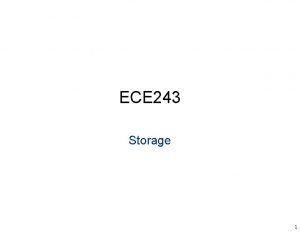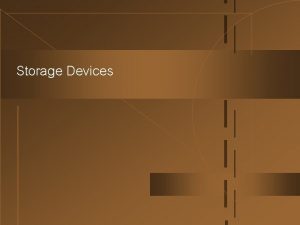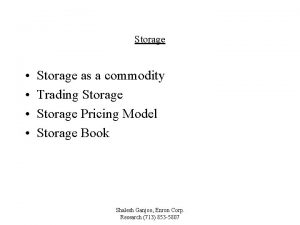Storage Networking Strategic DecisionMaking Randy Kerns Evaluator Group
































- Slides: 32

Storage Networking Strategic Decision-Making Randy Kerns Evaluator Group, Inc. www. evaluatorgroup. com

Agenda l Recap – What you’ve heard • Storage Networking • Definition, what problem is being solved • Differing Solutions • SAN – FC, IP (i. SCSI, i. FCP, FCIP) • NAS l Framework For Decision-Making • Evaluation • Requirements based on market segment • Where proposed solutions best fit • Considerations for your environment • Roadmap for choosing storage networking solution • Methodology to approach problem

Storage Networking l Definition – from SNIA • The practice of creating, installing, administering, or using networks whose primary purpose is the transfer of data between computer systems and storage elements and among storage elements. l What problems are being solved • Near-term: consolidation, backup • Wider-view: storage growth

Different Solutions l Storage Area Networks • Fibre channel based • Fabric switched network for SANs – High bandwidth – 1, 2 Gb/s now, 10 Gb/s mid 2002 – Low latency – hardware intensive implementation – Block I/O – SCSI as ULP for fibre channel • Interoperability – Solved with significant investment from vendors – Independent lab and certification underway – Maturing – significant deployment • Major vendors – Products – Commitment for long term • Management and the abstraction of storage

Different Solutions l Storage Area Networks • IP based • Over Ethernet with TCPIP encapsulation for most • Various methods – proposals for standards – Block I/O via encapsulation » i. SCSI – Tunneling » i. FCP » FCIP • Targeting OLTP at higher transaction rate than NAS

Different Solutions l Storage Area Networks • IP based – i. SCSI - uses SCSI commands over IP • Target is to provide block I/O using Ethernet infrastructure • No mechanism in Ethernet/IP to allow for command-response structure of SCSI • SCSI is block oriented storage interface • Uses a software driver to control SCSI protocol • Ethernet / IP has network characteristics • No flow control – drops packets on congestion • Packet size is limited – get smaller as contention increases • i. SCSI attempts to work within these constraints • • i. SCSI standard proposes to encapsulate SCSI on TCP Many vendors – some haven’t been in storage before

Different Solutions l Storage Area Networks • IP based – i. FCP, internet Fibre Channel Protocol • • • Transfers FCP across IP networks Gateways used to encapsulate FCP on IP Useful for extended distances for FC connections Translates FC frame addresses to new local IP address – ‘Transparent’ view of storage devices – Connects FC devices to TCP/IP backbone IP based – FCIP, Fibre Channel Internet Protocol • Tunneling FCP across IP • Gateways/switches act as E-port extenders • Useful for SAN to SAN linkage over extended distances • Does not change FC address of frames between SANs – Makes a large SAN with single address space

Different Solutions l Storage Area Networks • Infini. Band • Developing technology to replace PCI in servers • Will extend from server to fabric – Connect storage, networks, etc. – Switch / routers will be initial connect • Question is: when will native Infini. Band devices appear? • Infrastructure change – will happen – Probably 5 years to reach into storage

Different Solutions l Network Attached Storage • NAS Appliances • Remote file serving • Clustering option • Starting to see abstraction within same vendor solutions

Different Solutions l Network Attached Storage • DAFS • VI based • Remote DMA • File-based access • Targeting OLTP at higher transaction rate than NAS • YE 2001 availability

Different Solutions l Convergence – blurring of the lines • Gateway – NAS “head” • Connect to SAN storage • Benefits of scaling storage, administration

Different Solutions l Convergence – blurring of the lines • Metadata server solutions • NAS control for access • SAN block I/O for data to achieve high performance

Different Solutions l Convergence – blurring of the lines • Distributed SAN file systems • SAN data can be local file system Single File System Common file system on shared storage Highly available Application transparent Host A Host B Host C Cluster Sfw Cluster File System Cluster Vol SAN

Framework for Decision making l Evaluation • Understand your requirements • Business • Technical • Understand the vendor offerings • Targeted at a specific market segment • Characteristics may not fit your requirements • Need to have long-term view

Markets

Requirements by Segment l Enterprise Data. Center • • Reliability – 100% availability of data Guaranteed performance – response time, data rate Scalability – capacity and performance Security – guaranteed and provable Long-term support from vendor Tools for storage and performance management Integration into mature procedural environment

Requirements by Segment l Departmental (Small Business) / Workgroup • • Cost Simple administration Quick ROI Multi vendor: server, OS, storage systems l New E-business • • • Cost Simple administration Potential large capacity Availability by replication Mature into traditional IT environment

Where Does Solution Best Fit l Enterprise Data. Center • FC-based SANs • High performance, highly scalable • Designed for storage – fits requirements for enterprise storage • Security implementation / control familiar to storage professionals • Significant deployment in enterprise (Fortune 1000 companies) • NAS • Appliances in mainly R/O environments • Metadata server in file sharing / performance environments

Where Does Solution Best Fit l Departmental (Small Business) / Workgroup • IP based SANs • May be least cost • Few storage-only professionals (normally system administrators with multiple responsibilities) • Perception of simplicity • NAS • Appliances • SAN file systems • Gateway • FC based SANs • Complete solutions without major installation effort

Where Does Solution Best Fit l New E-business • In SSP and professional service installed / managed environments: FC based SANs • • IP-based SANs for existing and growth environments NAS • Appliances • Gateway • All of the above

Other Considerations l Considerations for your environment • Will there be multiple storage networks? • Independent? • Distance • What information needs to flow? • What are the bandwidth, response time requirements? • Plan for the future • Growth • Additional requirements – Security – applications

Storage Network Linkage l Enterprise to Enterprise • Data migration over extended distances • Performance requirements and distance dictate connection • Transfer over IP – Multiple solutions • ATM, other tunneling solutions • Business continuance • Remote copy – critical performance characteristic drive connection topology • SAN may be utilized by storage system to storage system copy (example PPRC) • System-level issue not just data movement

Storage Network Linkage l Enterprise to Enterprise

Storage Network Linkage l Departmental to Enterprise • • Data distribution, upload, etc. Data protection Dynamic access based on demand frequency IP or FC based – depends on economics, performance, administration, etc. • Distance required – campus based vs. extended distance • Centralized management, security, etc.

Storage Network Linkage l Departmental to Enterprise

Roadmap for Making Decisions l Determine strategic business requirements • business environment dictates requirements l Determine storage capacity and expected growth • benefit for implementing storage network • management costs with growth l Current operational changes required • short term and long term • staffing and infrastructure

Getting Started l Make an informed decision: use a solution provider or roll your own • expertise required • who do you call when there is a problem • • who’s going to manage this who guarantees it and will make good l Become educated in either case

Deployment l Consider a phased implementation • new technology introduction requires learning curve • • • asset protection ease of integration minimize risk l Start building infrastructure • physical plant • skilled staff

Deployment l Start with simple configuration • bring online first as shake-out • make it local • use the storage management software chosen • ensure common reporting mechanisms • make sure it works from the console you’ve chosen l Build larger configuration when satisfied l Get guarantee of interoperability!!!

Deployment l Test • failure modes • addition to capacity • addition of servers • addition of switches and hubs • service / maintenance (7 X 24) • performance • normal operations • degraded • limits • • backup restore

Deployment l If solution provider is also a storage vendor - test replacement of their storage device with a competitor l Review your management choice – it is the most important one to make

Summary l Many different solutions • Many from companies with no experience in storage products • Great deal of hype and mis-information now l One size does not fit all • Differing requirements • Economics matter • Administration value • Extensibility – handle growth l Linking Storage Networks is important planning requirement • Multiple organizations involved l Critical decision for your company – choose wisely
 Survey of household economics and decisionmaking
Survey of household economics and decisionmaking Shell
Shell Sdn introduction
Sdn introduction Cisco storage networking
Cisco storage networking Storage networking
Storage networking Metacircularity
Metacircularity Nowc adalah
Nowc adalah Marketing mix evaluator
Marketing mix evaluator Evaluator competencies
Evaluator competencies Ehtc governing system
Ehtc governing system Excel formula evaluator
Excel formula evaluator Veriforce oq evaluator
Veriforce oq evaluator Collegiate approach
Collegiate approach Function evaluator
Function evaluator Evaluator eol
Evaluator eol Emp moodle
Emp moodle External evaluator
External evaluator External evaluator
External evaluator Transferring of data from auxiliary storage to main storage
Transferring of data from auxiliary storage to main storage Secondary storage vs primary storage
Secondary storage vs primary storage Uses rigid metallic platters
Uses rigid metallic platters Unified storage vs traditional storage
Unified storage vs traditional storage Strategic fit vs strategic intent
Strategic fit vs strategic intent Strategic substitutes and strategic complements
Strategic substitutes and strategic complements Industrial organization model of above average returns
Industrial organization model of above average returns Tows matrix
Tows matrix Randy stamper
Randy stamper Randy pausch time management
Randy pausch time management Paul holden character traits
Paul holden character traits Randy pausch last lecture summary
Randy pausch last lecture summary Dr randy pausch
Dr randy pausch D. randy garrison
D. randy garrison Randy betz
Randy betz



